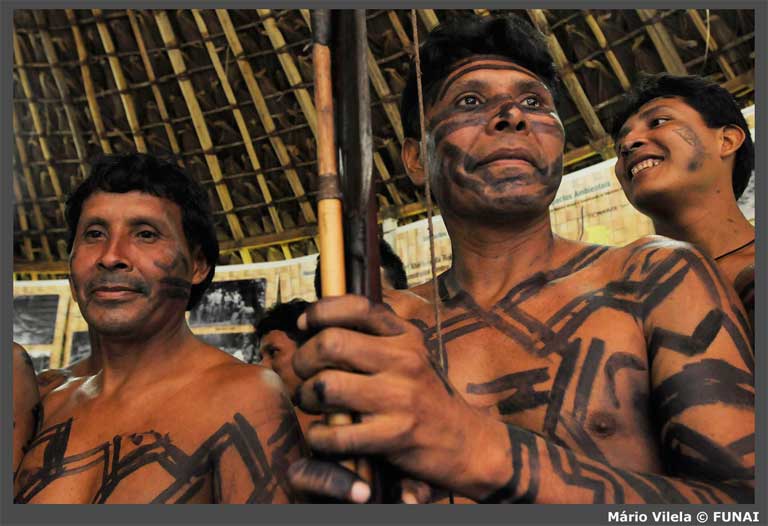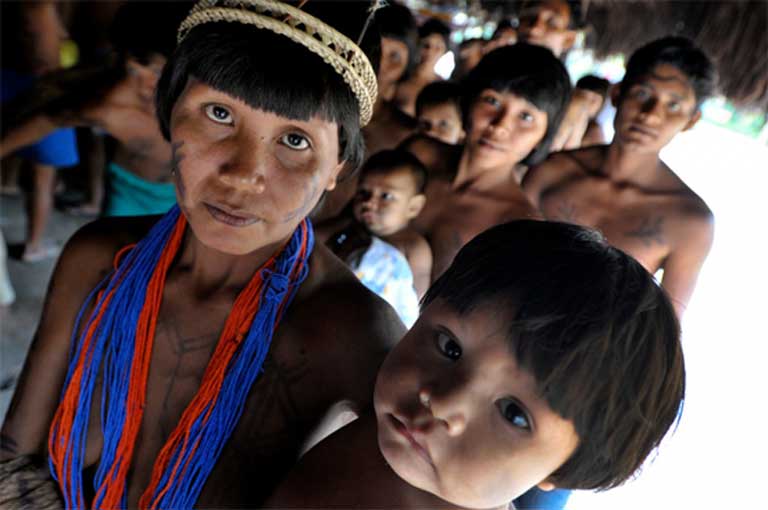- As a young man in the 1960s, José Porfirio Fontenele de Carvalho decided to resist Brazil’s brutal military dictatorship by going into the Amazon to help indigenous groups in their struggles against the military’s assault on their way of life.
- He made early contact with the warlike Waimiri-Atroari Indians, who were decimated in their struggle to block the BR-174 highway through their territory. The Indians tell of numerous atrocities committed against them by the government during this period.
- With Carvalho’s help, a new indigenous reserve, covering 2.6 million hectares (10,000 square miles), was established, along with a conservation unit — the Biological Reserve of Uatumã. Through the years, Carvalho won other concessions for the Waimiri-Atroari.
- Today, the group has increased its number to nearly 2,000, though the tribe continues fighting the government. President Temer is now determined to put a major transmission line through their lands. Most observers agree: without Carvalho’s assist, the Waimiri-Atroari would likely be extinct, and their forests gone. He died this month at age 70.

Sometimes a single person can change history. One such individual is José Porfirio Fontenele de Carvalho, who died on 13 May from cancer, aged 70. Without him, the Waimiri-Atroari, an indigenous group in Brazil, their way of life, and much of the forest they inhabit today would have vanished.
After Brazil’s 1964 military coup, he joined other young men who, rather than participating in the armed resistance, moved into the Brazilian interior to help defend indigenous communities who were suffering intensely from the government’s ambitious plan to open up the region with roads, dams, settlements and other big infrastructure projects.
About 7,000 Indians of different ethnicities died or “disappeared” during the 25-year rule of the military government, according to Maria Rita Kehl, the coordinator of the indigenous and peasant group in Brazil’s National Truth Commission.

Opposing the military government
Carvalho joined Brazil’s indigenous agency FUNAI in 1967, and worked in various parts of the country before deciding, with other young colleagues, to seek contact with the Waimiri-Atroari Indians, widely regarded as the country’s most violent indigenous group. At the time, the military was building the BR-174, a road running from Manaus on the Amazon river to the town of Boa Vista in the very north of the country — a route that would take it through the heart of Waimiri-Atroari territory.
The Indians resisted fiercely and the government fought back with brutal determination. Later, Carvalho told his story to the Folha de S. Paulo newspaper: “in the early 1970s we went to see General Gentil Nogueira Paes [head of the Amazon Military Command] to ask him to stop the road. He told us: ‘I am going to build this road, even if I have to kill these Indian assassins. I have given orders for the men to shoot.’” The Brazilian army did not wish to comment for this story on the general’s remark.
Although a thorough official investigation was never done, the Waimiri-Atroari say they were treated appallingly. Tomás Tamerré, an Waimiri-Atroari indian, told the National Truth Commission: “The road arrived with the army. The Indians shot arrows at a plane. Then the plane flew over the villages and threw out something that scorched people. They soon died.”
Carvalho and his colleagues were desperate to make peaceful contact with the Indians to prevent them being wiped out. But this was dangerous work, as the Waimiri-Atroari had no way of distinguishing between “whites” set on killing them and those wishing to protect them.
“We made a pact that, however many of us were killed [by the Indians], the survivors would carry on until the last man fell,” Carvalho said. And many were killed, including Carvalho’s close friend, Gilberto Pinto Figueiredo. Carvalho was eventually arrested by the government and charged under the National Security Law.

He moved to another region with the intention of taking up another indigenous cause. But the Waimiri-Atroari, who continued to face serious problems, even after the BR-174 was built, had other ideas. Mario Parwe, whose father died in a clash with “whites,” and one of the group’s main leaders today, explained what happened: “We went to Brasilia and asked FUNAI where [Porfírio Carvalho] lived. We found him, talked to him and he said he would come back and help us.”
It was this fateful decision that likely saved the Waimiri-Atroari. Carvalho was shocked at what he saw on his return: “I had carried out a census [in 1969] and counted about 1,500 Indians in 15 villages. When I returned in 1986, there were just 374.” By then General João Baptista Figueiredo, one of the military presidents, had scrapped the Waimiri-Atroari’s indigenous reserve so that a mining company, Paranapanema, could open a tin mine there.
Instead, with Carvalho’s help, a new reserve, covering 2.6 million hectares (10,000 square miles), was established, along with a conservation unit — the Biological Reserve of Uatumã — to act as a buffer between the Indians and the economic frontier.
Indigenous victories
Carvalho and the Waimiri-Atroari didn’t manage to stop the Balbina hydroelectric power station from being built on their land in the late 1980s. The dam has been widely criticized for its serious environmental impacts and its low efficiency and was particularly disastrous for the Indians, as it led to the dislocation of about one third of the surviving members of the tribe.
However, the Waimiri-Atroari did succeed in getting a sizable compensation from the state electricity company, Eletronorte, the first time such a payment was ever made to an indigenous group. Under Carvalho’s guidance, the Indians used the money to set up the PWA (Waimiri-Atroari Program) to fund improvements in living standards and land protection.

Another victory came in early 1995. When the government moved forward with plans to pave the BR-174 without consulting the Waimiri-Atroari, the Indians occupied the highway. Márcio Santilli, who later set up the NGO Socioenvironmental Institute (ISA), walked into the middle of the BR-174 battle when he took over as FUNAI president in September 1995.
And Santilli knew immediately who to contact: “The first phone call I made was to Porfírio Carvalho,” he recalled. The two men arranged a mission, made up of highly placed representatives from various federal ministries and the state government, to meet with the Waimiri-Atroari in one of their villages. For many “whites” this first visit to an indigenous community was a frightening prospect.
But all went well. The Waimiri-Atroari agreed to the paving in exchange for increased PWA funding. A sticking point was the Indians’ demand for up-front funding for a ten-year period — a request the Planning Ministry representative was reluctant to concede. According to Santilli, the Indians initially wouldn’t say, but finally admitted, why this concession was so important to them: “We don’t trust you,” they explained.
Once a deal was reached, it was determined that each of the participants should be given a copy of the meeting minutes to avoid future squabbling. But in those days there were no computers, so Carvalho searched out a manual Olivetti typewriter (with the letter ‘n’ missing) with which one copy was typed and seven carbon copies made. It was, until recently, a lasting pact.
The agreement worked out well for the Waimiri-Atroari, with much of the money spent monitoring the highway to prevent illegal occupations by land thieves, farmers and settlers. According to Santilli, “the PWA is the most successful official program of indigenous action that I know.”

The Waimiri-Atroari today are in good health and their number has increased to 1,935, an outcome which Carvalho relished. Shortly before his death he declared: “I feel the happiest person in the world, because I see the Waimiri-Atroari interacting peacefully with non-Indians and, at the same time, there in the forest, they carry on with their dances and hold their marubás [celebrations], without any outside interference.”
Trouble with Temer
That being said, the Waimiri-Atroari, like other indigenous communities in Brazil, continue having conflicts with federal authorities, particularly with the current Temer administration.
The government wants to route the Manus-Boa Vista electric transmission line through the Indians’ reserve. The Waimiri-Atroari, and FUNAI staff, strongly oppose the plan. The line could take an alternative route, but would cost more. Carvalho strongly supported the Indians on this issue, which, as of now, remains unresolved.

Just a week before he was sacked from the presidency of FUNAI in early May, Antonio Fernandes Toninho Costa (who lasted less than four months in the job), was summoned by President Temer and ordered to remove the Waimiri-Atroari from their lands along the line’s proposed 125 kilometer route. Some have linked Toninho’s dismissal to his unwillingness to take this action.
Carvalho was confident at the time of his death that the Waimiri-Atroari would manage perfectly well without him. Indeed, he was very modest about his achievements: “I was just an animator, a stubborn dreamer who carried the utopia of a 20-year-old into Amazonia.”
Santilli believes that Carvalho’s role was far greater: “Of course, the heroism, the fighting spirit and the determination of the Waimiri-Atroari contributed to the success of the PWA.… But all involved are unanimous in saying that the main credit should go to Porfírio Carvalho, to whom I offer my most profound thanks.”
FEEDBACK: Use this form to send a message to the author of this post. If you want to post a public comment, you can do that at the bottom of the page.
